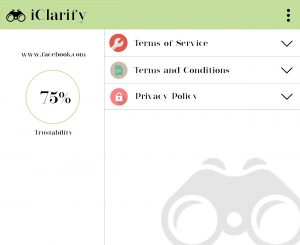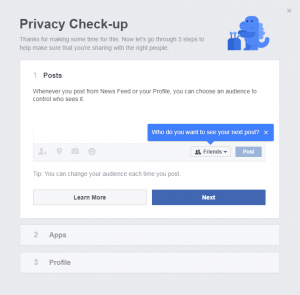iClarify: About The Control and Understanding of Our Privacy.
iClarify: About The Control and Understanding of Our Privacy.
“I HAVE READ AND UNDERSTAND THIS AGREEMENT, AND I ACCEPT AND AGREE TO ALL OF ITS TERMS AND CONDITIONS”
This might be one of the biggest lies on the internet. Not even the prominent writing in all caps, or – as most internet users would say – the shouting, makes it any less of a lie. The statement is well known from the Terms of Service (ToS), Terms and Conditions (TaC), or Privacy Policy (PP) from software and online services. On the internet and especially on network websites, privacy policies can be seen everywhere, literate estimates that more than 77% of the sites deploy a privacy policy (Jensen and Potts 471). In order to regulate privacy policies, some authorities have proposed to establish the principles of privacy policy and advocate the sites to observe these principles when making a privacy policy (Federal Trade Comission 69; OECD). Despite those interventions, the ToS, ToC and PP remain difficult for users to understand. Even worse, in the face of the unilateral terms given by the site, the user can only select yes or no and cannot choose the type of information to disclose and the way they are used. This method has caused a serious drawback (Liu 521).
85% of adults consider it important to control your personal information online (Bélanger and Crossler 1017). But users are mostly left alone when it comes to choosing the right settings for protecting their data and therefore privacy. Thus, the privacy policy is an important tool for users to control the collection, processing, distribution and use of personal information. (Cranor, Gudru, Arjula 135). However, tiny font size, complicated word choice and vague phrasing often make the documents an unpleasant read. Only about a quarter of people click on the ToS before agreeing to them (The Guardian, 2017). By making the terms an unpleasant read, platforms keep users from being too aware of what they agree to and stay clear of potential liability claims by users (Beazley 2). This is not all that new and recent efforts by platform giants show the willingness to improve the readability of the agreements. Facebook, for example, introduced their feature Privacy Check-up to give users an overview through privacy settings and to explain them. Yet still terms and privacy policies are exhaustive and dense on information. In this essay a technical solution to this issue will be presented. A browser extension, which we will call iClarify, will serve as informant and reminder of the terms of the website the user is visiting. iClarify will make the reading and understanding of the terms much easier for the user and it will empower users to regain control over their privacy. iClarify will serve as critique on state of the art terms and policies of platforms, and most importantly iClarify will intervene with this paradoxical notion of users being concerned about their privacy while simultaneously giving it all away.
Our Terms and Privacy Policies in Theory
This project will discuss the debate within new media studies around privacy and control of data. More and more online services are offered completely free of charge. To enable this for their users, the platforms gather data in order to create revenue through advertisements (Van Dijck 170). For users this means that every action online is being tracked, stored, analyzed and ultimately monetized, which can certainly appear to be invasive. Westin, one of the key scholars in privacy theory, predicted that user will develop a psychological barrier when technology becomes more and more invasive. Users would give away less information and reduce their communication (Westin 31). Yet, this seems contradictory when only a quarter of users click on the terms. While users claim to be interested in privacy, their actions tell a different story; this is defined as the privacy paradox (Barnes n. pag.). Privacy seems to be in decline, however, platforms are giving more options to users for taking control over their data. On Facebook for example, users can keep up to date with the Privacy Check-up offered by the platform. But still users know little about the terms that they agree to or where to find the right information (Debatin et al. 87).
When accepting the terms and policies of a platform, users accept a certain context, prescribed by the platform, that is, if privacy is understood in a sense of contextual integrity (Nissenbaum 106). Law scholar Nissenbaum gives a gives an alternative approach to understanding an unease with surveillance not as an issue of privacy. According to her it is a problem of contextual integrity. Contextual integrity describes privacy as highly context-dependent. Information a user would regard personal information in one context might be not so personal in another (Nissenbaum 119). She describes this contextual integrity consists of appropriation and distribution. The former concerns the content of information, since a person might tell their doctor something, they would not share with their employer. So information has to be appropriate for the situation (Nissenbaum 120). Distribution describes the flow of information, as Nissenbaum explains, the flow should be free of choice, discrete and confidential in a bidirectional setting, however, different contexts require other, more open flows of information (124). Appropriation and distribution of personal information are cornerstones of terms and policies. With their agreements platforms cover many contexts in which to appropriate or share user data, but they are not always necessary to offer a certain online service. To be able to understand and to make use of the options platforms give their users, they first have to find out about them and that is where our extension iClarify comes in.
Methodology
In order to realize iClarify we will develop the add-on through a series of phases that help us to articulate the specific problem within the framework of the relevant literature and current developments around ToS, TaC and PP. This will enable us to design an extension that can govern the specific lacks we will encounter and solve our found problem in relation to this framework. Following Gitelman we see data not merely as abstract and aggregative but also as having the potential to be mobilized graphically as to be used for explanation and arguments (Gitelman 12). Based on the literature discussed above, we will make decisions on what ToS, TaC, and PP to highlight in iClarify. Then information will be gathered about the current state of the art in ToS, TaC and PP. This will allow us to connect the literature to our research object and to formulate our initial problem as to understand in which way the research object will be handled. We will present designs of how our extension will look like and how it will visualize privacy. This will be done by taking in account the different steps that are needed to get the raw data into forms that are visible and legible for the user; in other words thinking about the way data can made visible for the eye and the mind (Gray et al. 242). This connection between data and eye is also inspired by Nissenbaum’s contextual approach that has been mentioned earlier and gives us the opportunity to ask what kind of parties, companies and publics are involved and which will serve as guidelines as how to best visualize the data. With this add-on we will join the data sources and digital technologies that next to the enrollment of user in the digital also become enacted to actively participate and position themselves on the new emerging digital platforms (Ruppert & Savage 18).
iClarify and its Affordances

Picture 1: iClarify Logo
iClarify is a browser extension that helps users truly understand the Terms of Service, Terms and Conditions, and Privacy Policy they are agreeing on the Internet. The extension introduces concise information of the ToS, TaC, and PP through better and interactive pop-up display on user’s browser. Over the use of striking symbols and fonts for instance, such extension to a greater extent can increase user’s attention towards understanding the information better. The information will be collected by the application crawling the ToS, TaC, PP and outgoing links as well as a database of information collected by us and iClarify users. iClarify will be on user’s browser at all times, however, when user is about to sign up for an account creation and agree on the terms, the iClarify symbol will appear on the corner right of the browser. When clicking the symbol, user is able to click on the three drop down menus that explains briefly ToS, TaC, and PP in each section. Surely, each section comprises of interactive display of information allowing the user to be more engage with what he/she is agreeing on. What is interesting with such extension is that iClarify will also warn users when the ToS, TaC, or PP are not in line with the standard regulation of an agreement. This is done through showing the percentage of the ToS, TaC, and PP reliability on the extension display.
With iClarify, we try to encourage users to be more attentive on what they are giving up online. In order to reduce the complexity of the ToS, TaC, and PP, iClarify reduce exhaustive information into one sentence with compelling fonts and symbols, and understandable use of language. Evidently, shortening such information will not be a complication as iClarify intends to extract keywords from each ToS, TaC, and PP. The appropriateness of its usage can be measured by the degree of how much the tool itself suits users’ needs. Through an interface analysis, we will identify iClarify’s functional, cognitive and sensory affordances, so we can assess this extensions’ usefulness for users in the online sphere (Stanfill 1060).

Picture 2: iClarify Browser Extension Interface

Picture 3: iClarify Notification Pop-up in the lower right corner
The functional affordances of the browser extension provide precise and easy information of the ToS, TaC, and PP of various online platforms. As users often neglect to attentively read through all the ToS, TaC, and PP when signing up in an online platform due to its long and exhaustive information, users are not aware of what they are giving up online. Evidently, iClarify turns users’ negligence on online privacy into an interactive and user-friendly object. The cognitive affordances help users to comprehend iClarify’s functionality. When looking at the appropriate use of symbols next to each text, iClarify allows users to process information easier (Stanfill 1063). Clearly, proper choice of texts and symbols used in the extension can help the process of meaning making (Stanfill 1063). Lastly, iClarify’s sensory affordances reflect on its interactive symbols and fonts used on the extension to attract users’ attention. As mentioned by Stanfill (1064), sensory affordances are often linked with the visibility of the interface’s aesthetic. Through appealing display of the extension, iClarify indicates credibility and professionalism that can attract users. Clearly, with the existing problem of users avoiding reading exhaustive information provided in the ToS, TaC, and PP, iClarify is providing users with a better tool to understand their agreements. When comparing such extension to Facebook Privacy Check-up for example, iClarify will be an advantage due to its accessibility both on users’ browsers and its presence when signing up on an online platform. Facebook Privacy Check-up itself mainly focus on who can see ‘what users post’ or what kind of apps are allowed to access users’ Facebook profiles. Whereas, the main idea of iClarify is to inform users of the ToS, TaC, and PP they are agreeing using a much interactive and simplified display. On top of that, such extension will always be available at all times, popping up into users’ display when signing up on an online platform such as Facebook.

Picture 4: Facebook Privacy Check-up Interface
Visualization of the Terms
To increase the validity of our research, we have analyzed the ToS, TaC, and PP from 39 main websites, and built a trust score system along their terms. The terms are divided into different topics with scores. The higher the score, the more trustworthy the website is. We used an Excel sheet for our data visualization to simplify and order otherwise dense information, for explanatory and communicative purposes. it may help us to analyze, alter, browse, and explore complex information. (Gray et al. 2016: 228)

Picture 5: ToS, TaC, and PP visualization of 39 popular websites
Conclusion
This essay proposes a browser extension which will offer visualization, understanding and interaction with Privacy Policies, Terms & Conditions and Terms & Services found on the internet. Our intervention, iClarify, is a response to lack of intelligibility and loss of user control on online services that use these policies. The add-on will show the user in a transparent and understandable way the content of these policies and empower them to regain control over their data. The extension is part of the continuing debate around digital privacy and control. On the one hand the monetization of personal data as revenue through advertisements and on the other contextual integrity that states that privacy is context dependent. The add-on itself will function as an interactive pop-up with explanations with which the user can engage and at the same time notes divergences from the basic policies as articulated on most online services. We have used an interface analysis to discern the functional, cognitive and sensory affordances of iClarify as to develop the add-on in such a way that is best suited to the users’ needs and uses. Perhaps the time will finally come that the user can honestly say “I have read and understood this agreement”
List of References
Allison, David S., Hany F. El Yamany, and M. Capretz. “Metamodel for privacy policies
within SOA.” Proceedings of the 2009 ICSE Workshop on Software Engineering for
Secure Systems. IEEE Computer Society, 2009.
Beazley, Mary Beth. “Hiding in Plain Sight: Conspicuous Type Standards in Mandated
Communication Statutes.” J. Legis. 40 (2013): 1.
Bélanger, France, and Robert E. Crossler. “Privacy in the digital age: a review of information
privacy research in information systems.” MIS quarterly 35.4 (2011): 1017-1042.
Berreby, David. “Click to agree with what? No one reads terms of service, studies confirm.”
The Guardian, Guardian News and Media Limited, 3 Mar. 2017,
<www.theguardian.com/technology/2017/mar/03/terms-of-service-online-contracts-
fine-print>.
Cranor, Lorrie Faith, Praveen Guduru, and Manjula Arjula. “User interfaces for privacy
agents.” ACM Transactions on Computer-Human Interaction (TOCHI) 13.2 (2006):
135-178.
Debatin, Bernhard, et al. “Facebook and online privacy: Attitudes, behaviors, and unintended
consequences.” Journal of Computer‐Mediated Communication 15.1 (2009): 83-108.
Federal Trade Commission. “Protecting Consumer Privacy in an Era of Rapid
Change: Recommendations for Businesses and Policymakers, March 2012.” 69.
Gitelman, Lisa. “Introduction chapter.” Raw Data Is an Oxymoron. Ed. Lisa Parks
Cambridge: MIT Press, 2013.
Gray, Jonathan, Liliana Bounegru, Stefania Milan, and Paolo Ciuccarelli. “Ways of Seeing
Data: Toward a Critical Literacy for Data Visualizations as Research Objects and
Research Devices.” In Innovative Methods in Media and Communication Research,
Eds. Kubitschko, S. and Anne Kaun. Springer International Publishing, 2016. 227–
252
Liu, Yue. “User control of personal information concerning mobile-app: Notice and
consent?.” Computer Law & Security Review 30.5 (2014): 521-529.
Nissenbaum, Helen. “Privacy as contextual integrity.” Washington Law Review 79 (2004):
119.
Ruppert, Evelyn. Law, John. & Savage, Mike. “Reassembling Social Science Methods: The
Challenge of Digital Devices.” Theory, Culture & Society , 30(4), (2013) pp.22–46.
Stanfill, Mel. “The interface as discourse: The production of norms through web design.”
New Media & Society, vol. 17, no. 7, 2014, pp. 1059–1074.,
doi:10.1177/1461444814520873.
Van Dijck, José. The culture of connectivity: A critical history of social media. Oxford
University Press, 2013.
Westin, Alan F. “Privacy and Freedom, New York: H.” Atheneum (1967).